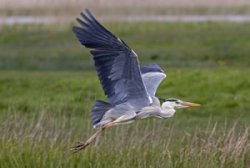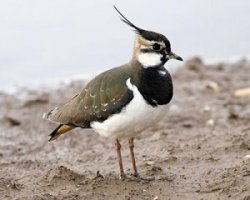Grey Herons – a success story
The first BTO survey actually pre-dates the Trust. Started in 1928 by several of the founders of the BTO, the Heronries Survey involves spring-time counts of active heron nests in the spring. With no break for the war, this is a unique data-set, illustrating the recovery in numbers of Grey Herons, as water quality has improved and persecution has decreased. Herons suffer in cold winters and the crashes associated with the winters of 1946-47 and 1962-63 show clearly in the 80-year history of the survey. What will be the effect of this last winter’s weather? Heronry volunteers will be letting us know their counts shortly – as well as numbers of newly-arrived Little Egrets.
Birds and our food
Much of the early research by BTO members focused on issues that were relevant to farmers and fruit-growers, as shown by an enquiry between 1935 and 1938 looking at the destruction of flowers and buds by birds. The 1944–46 Rook Survey aimed to understand the distribution of this species whilst a study of the pellets coughed up by birds (some of the contents of which are still in our archives) established whether these birds were eating insects or grain. Other surveys during this period looked at Little Owls and Woodpigeons. Food security was a big issue, especially during the Second World War.
BTO and bird ringing
Every year, the BTO celebrates the life of Harry Forbes Witherby, when an eminent ornithologist delivers the Witherby lecture. Amongst other things, Witherby set up one of the two ringing schemes launched in Great Britain in 1909. Stewardship of the scheme moved from British Birds to BTO soon after the Trust was formed in and we now have 2,600 trained bird ringers catching about a million birds each year. Our birds link us to places as far away as Siberia, Canada, South Africa, Brazil and even Antarctica. You can see up-to-date migration maps in the online ringing report.
We’ve always liked Lapwings
Concern for Lapwings is not a new thing – these are much loved birds – and BTO has never been shy of trying to understand why these and other birds are found where they are. The earliest survey in the BTO’s archives in which birdwatchers collected habitat data was the 1937 Lapwing habitat survey. These days, our volunteers are getting used to the fact that we are keen for them to distinguish crops and types of woodland, collecting valuable habitat information alongside that for birds. We have gone further though, collecting data on other taxa such as butterflies and mammals and sharing them with partner organisations, as evident in the bolt-on butterfly survey for BBS squares.
1939 Nest Record Scheme – climate change
The Nest Record Scheme was born in 1939, as the Hatching & Fledging Enquiry with the simple aim of collecting information on nest sites, clutch size, timing and breeding success. There was no suggestion that springs would start to become earlier and that the timing of nesting would capture a new phenomenon called climate change. Nest records are a jewel in the BTO crown, helping to explain why populations of species such as Yellowhammer and Willow Warbler are in decline. Although climate change may not have been an issue in the 1930s, it’s interesting to note that one of the drivers of the 1935 Great Crested Grebe Survey was to study the effect of drought on waterbirds.
It wasn’t called citizen science …
From its early days, the BTO has used newspapers to engage with people interested in birds. There were several behavioural studies in the first 20 years of the Trust but none captured the imagination of people more than the study of the spread of the (annoying) practise of stealing the cream from the top of milk bottles. Blue and Great Tits were the main culprits but other species also took advantage of this door-step delivery. Once milk was homogenized – so that the cream did not so readily rise to the top – and with fewer people using the services of milkmen, the behaviour started to die out. We still get occasional reports – which is a nice nod to the BTO’s history.


